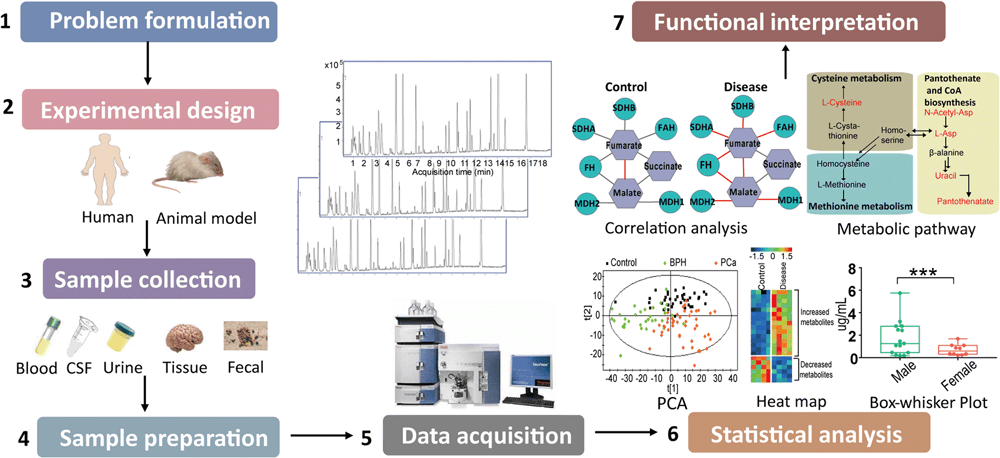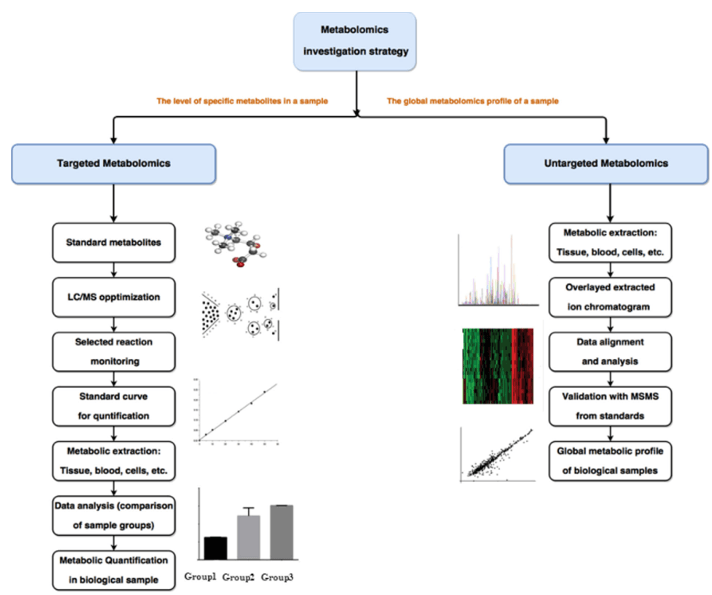Overview
The human and animal metabolomics service uses high-throughput detection techniques to study the types and quantities of metabolites in organisms and their changes in order to elucidate the metabolic process of the body during normal life states and environmental changes. The main contents of metabolomics analysis include:
- Qualitative and quantitative analysis of metabolites
- Metabolomics phenotypes of organisms with different genotypes
- Analyze the metabolic pathways or networks of individual metabolites in response to different environmental and physical, chemical, or biological stimuli.
Human and Animal Metabolomics Analysis Methods
Creative Proteomics offers several methods for different human and animal metabolomics applications.
Instrumentation
Creative Proteomics employs state-of-the-art LC-MS/MS and GC-MS/MS systems for human and animal metabolomics studies.
Our primary instruments include:
- AN Sciex Qtrap 6500 Plus
- AB 5600 Triple TOF
- Agilent 7890-5977
- Thermo TSQTM 9000
 Analytical workflow of metabolomics studies (Shao et al., 2019)
Analytical workflow of metabolomics studies (Shao et al., 2019)
Sample Preparation
- Animals and clinical tissues: ≥ 200 mg, and the tissues should be flushed with PBS until the blood is removed.
- Cell samples: collect cell pellets, rinse with PBS 3 times to remove residual serum. The sample volume is 1×107 or the cell pellet is not less than 50 μl.
- Plasma/serum sample: fresh blood is taken out, anticoagulated or coagulated, centrifuged at 4°C, and the supernatant is taken to obtain plasma/serum. During the preparation process, ensure that hemolysis is not allowed, and the recommended sample volume should not be less than 250 μl.
- Urine: ≥ 1ml
- Saliva: ≥ 0.5ml
- Cerebrospinal fluid: ≥ 100 μL
- Stool and intestinal contents: ≥ 200 mg
Data Analysis
- Parametric and non-parametric unit-variate statistical tests: t-test, analysis of variance (ANOVA), etc.
- Differential metabolite screening: principal component analysis (PCA), PLS-DA
- Clustering analysis: hierarchical clustering analysis, K-means, etc.
- Metabolic pathway enrichment analysis
- Integrate metabolomics data with transcriptomics, proteomics, and phenomics studies
Applications of Human and Animal Metabolomics
Biomedicine: To detect the difference of metabolites in human tissue samples, conduct related mechanism studies, biomarker analysis, etc. Detection of human and animal models related to human studies and analysis of differential metabolites.
Human and animal science: comparison of different traits among different varieties and strains, evaluation of production performance, improvement of meat quality and evaluation of milk quality, etc.
Agricultural insect and pest control: it can be used for the research of insect resistance, growth and development, behavior, molecular mechanism and so on.
Aquaculture: suitable for fish disease control, immunity, growth and development, nutrition related research, and combined with multi-omics, the study of related molecular mechanisms.
Creative Proteomics offers several approaches to study human and animal metabolomics and deliver precise and detailed data and analysis report. We can also customize methods or establish new methods together with our collaborators to meet the specific needs of any project.
Reference
- Shao, Y., & Le, W. (2019). Recent advances and perspectives of metabolomics-based investigations in Parkinson's disease. Molecular Neurodegeneration, 14(1), 1-12.
For Research Use Only. Not for use in diagnostic procedures.


 Analytical workflow of metabolomics studies (Shao et al., 2019)
Analytical workflow of metabolomics studies (Shao et al., 2019)




